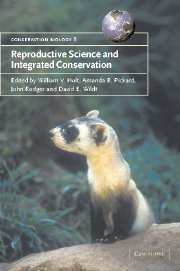Book contents
- Frontmatter
- Contents
- List of contributors
- Foreword
- Part I Introduction
- Part II Reproduction and population viability
- Part III Reproductive techniques for conservation management
- Part IV Integrated conservation management
- Part V Reproduction science in non-mammalian species
- 21 Reproductive technologies and challenges in avian conservation and management
- 22 Reptile reproduction and endocrinology
- 23 Reproductive research and the worldwide amphibian extinction crisis
- 24 Reproduction in fishes in relation to conservation
- Part VI Conclusions
- Index
- References
23 - Reproductive research and the worldwide amphibian extinction crisis
Published online by Cambridge University Press: 21 January 2010
- Frontmatter
- Contents
- List of contributors
- Foreword
- Part I Introduction
- Part II Reproduction and population viability
- Part III Reproductive techniques for conservation management
- Part IV Integrated conservation management
- Part V Reproduction science in non-mammalian species
- 21 Reproductive technologies and challenges in avian conservation and management
- 22 Reptile reproduction and endocrinology
- 23 Reproductive research and the worldwide amphibian extinction crisis
- 24 Reproduction in fishes in relation to conservation
- Part VI Conclusions
- Index
- References
Summary
INTRODUCTION AND BACKGROUND
This chapter is devoted to stimulating interest in amphibian reproduction and inspiring an appreciation for the challenges and benefits of such research in this largely ignored taxon that is facing a world-wide extinction crisis.
Taxonomic distribution
Amphibia can be divided into three orders: (1) Gymnophiona (caecilians), (2) Caudata (salamanders and newts) and (3) Anura (toads and frogs). Caecilians are worm-like, burrowing, legless amphibians living underground in tropical environments. Little is known about animal numbers within most of the 156 species in this order, but two species are listed by CITES as ‘Endangered’ or ‘Threatened’ (IUCN Red Book, 2000). The Caudata comprise 440 species of salamanders and newts that primarily inhabit the Northern Hemisphere. A few species extend to southern Brazil, Bolivia and Southeast Asia. Although there is concern about many of these species, only three are considered ‘Critically endangered’, eight ‘Endangered’ and 26 ‘Vulnerable’ (IUCN Red Book, 2000). Anurans are the most broadly dispersed and abundant amphibians with 4360 species identified (about the total number of mammalian species known). Twenty-two anuran species are considered ‘Critically endangered’, 29 ‘Endangered’ and 56 ‘Vulnerable’ (IUCN Red Book, 2000).
The amphibian extinction crisis
There is a rapid and alarming disappearance of amphibian species in seemingly undisturbed ecosystems. A semi-aquatic lifestyle and a highly permeable skin render amphibians vulnerable to changes in water and/or atmospheric quality. Their dependence on moisture for reproduction also places populations at risk, even during minor perturbations in weather and habitat.
- Type
- Chapter
- Information
- Reproductive Science and Integrated Conservation , pp. 359 - 374Publisher: Cambridge University PressPrint publication year: 2002
References
- 4
- Cited by

